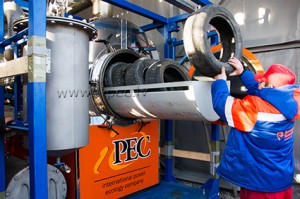As the complementary the motor industries grow, the accumulation of used tyres will increase in near future, which will lead to environmental excursion. More than 3 million tons of waste tyres annually produced only in United States, and up to 2.5 million tons in Europe. The disposal of scrap tyres occupies large amounts of valuable landfill space, poses fire and environmental threat!
Naturally, the decomposition of waste rubber goes beyond 100 years, accompanied by poisoning the soil and chemical release. The impact on the environment can be minimized by viable alternative for the disposal of used tyres through introduction of conversion technologies of ELTs tyres.
Today, the world’s waste management recognizes a wide range of technologies that could be used to divert a part of the rubber waste, which is currently being landfilled, and other hydrocarbon materials.
These technologies can be classified as follows: physical and chemical.
Physical Technology:
- Mechanical recycling
- Low temperature treatment
- Degradation and compression recycling
Chemical Technology:
- Trioxygen recycling
- Pyrolysis
Each technology provides two key meaningful and valuable products:
1. Rubber granulate
2. Tire-derived fuel (TDF)
A large number of scrap tyres is used in crumb rubber applications. In the future of paving, the rubberized asphalt concrete is a viable end-use of tyres. In the long term of molded rubber products, millions of waste tyres are used for the production of rubber granulate. Furthermore, test results show the crumb rubber used as soil additives increases its permeability and airflow.
Tire-derived fuel (TDF) can be used in cogeneration application or cement kilns, pulp and paper mills and industrial boilers; carbon can be burned on site for alternative energy recovery or be sold for the needs of different applications.
The product depends on the type of input material composition, tyres type used as feedstock and particular process requirements.
Scrap Tyre To Rubber Granulate
- mechanical recycling
Mechanical recycling is based on tyre shredding, separation of the cord, and next gridding of crumb rubber to powder. Disadvantages of this technology are the higher power consumption, the rapid depreciation of equipment and the low quality of the final product due to the amount of contaminants in the crumb.
- low-temperature treatment
Low temperature (cryogenic) treatment of old tyres performs at temperatures ranging from -60 °C to -90 °C, when the rubber is in a crack-sensitive state. Advantages provided by this technology are metal and textile improved separation and yield of rubber product. Disadvantages of this technology are the high price of coolant (liquid nitrogen), energy consumption and complexity of delivery.
- degradation and compression recycling
Scrap tyres are fed through openings in the chamber where the high pressure is divided into a steel cord, textile and rubber crumb. Among the disadvantages of this technology, the rapid depreciation of the equipment, higher power consumption and multi-level system of rubber granulate.
- trioxygen recycling
The technology is based on the oxidation of the old tyre to rubber granulate. Steel and textile cords are completely separated during the trioxygen processing. High speed contributes gridding. The minimum energy involved. Disadvantages of this technology are expensive equipment, high explosiveness, the highest hazard class of trioxygen.
Scrap Tyre To Fuel
- pyrolysis
 As the thermal decomposition, pyrolysis can be used to convert used tyres, and other hydrocarbon materials into useful products such as oil, synthetic gas and carbon black. The cracking process is carried out under high temperatures and without the addition of air or oxygen. As lower the temperature as more pyrolysis oil is obtained. As higher temperature as more syngas is produced.
As the thermal decomposition, pyrolysis can be used to convert used tyres, and other hydrocarbon materials into useful products such as oil, synthetic gas and carbon black. The cracking process is carried out under high temperatures and without the addition of air or oxygen. As lower the temperature as more pyrolysis oil is obtained. As higher temperature as more syngas is produced.
The oil obtained from the pyrolysis process may be used as a low-quality fuel in boilers or separated into fractions such as diesel fuel, gasoline, and heavy oil. Pyrolysis gas, as a rule, meets the needs of energy systems by heating process.
Pyrolysis technology is one of the most environmentally friendly, energy and cost-effective solution for the treatment of a wide range of rubber products at the international market of waste management. It became popular in the most developed countries such as the US, Japan, Germany, Switzerland and others.
When using the material or any part of it the link to the website (www.i-pec.lv) is required





